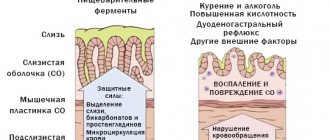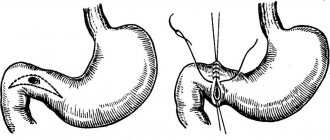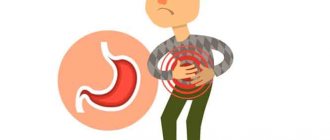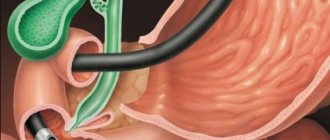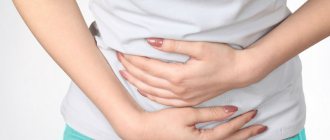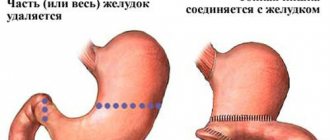Erosive gastroduodenitis is an inflammatory disease that is characterized by damage to the epithelial layer of the stomach and duodenum and the formation of erosions (defects of the mucous layer, which, unlike ulcers, do not affect the submucosa and muscular membranes). Symptoms of the disease may include pain in the epigastric zone, heartburn, vomiting with the presence of dark blood clots and black stools. To diagnose erosive gastroduodenitis, esophagogastroduodenoscopy with biopsy and determination of the presence of Helicobacter pylori infection is used. Treatment is aimed at reducing the acidity of gastric juice, eradicating Helicobacter pylori and protecting the mucous membrane.
Causes
Erosive gastroduodenitis can occur against the background of the aggressive influence of various negative factors - external and internal. Most often, the following exogenous factors lead to the development of this pathology:
- Helicobacter pylori infection;
- prolonged stress;
- poor nutrition;
- gastrointestinal diseases.
- eating rough or spicy foods, hot or too cold drinks;
- taking medications (non-steroidal anti-inflammatory drugs, glucocorticoids);
- alcohol abuse.
Among the endogenous causes, it is worth highlighting hereditary genetic disorders, increased production of hydrochloric acid, the presence of reflux of duodenal contents into the stomach, a decrease in the protective properties of gastric mucus, intestinal infections, and concomitant pathology of the liver and pancreas.
2. Reasons
Chronic gastroduodenitis is a typical polyetiological disease, i.e. it always develops under the influence of a certain set of causes and risk factors. These include:
- hereditary predisposition;
- distortions and errors in the daily diet;
- unhealthy lifestyle (especially a combination of overwork and lack of sleep);
- smoking;
- intoxication with certain groups of chemicals;
- pathology of adjacent parts of the gastrointestinal tract;
- endocrine disorders;
- increased acid secretory activity with simultaneous mucus deficiency;
- unfavorable psychological factors (chronic gastroduodenitis definitely refers to the so-called psychosomatic diseases).
In addition, today the presence of the bacterium Helicobacter pylori in the organs of the digestive system is of particular, if not decisive, importance in the etiopathogenesis of gastroduodenitis.
Visit our Gastroenterology page
Pathogenesis
Against the background of increased acid formation and reverse reflux from the duodenum, cell regeneration in the epithelial layer is inhibited, resulting in the formation of erosive defects. Exogenous factors play a significant role in the progression of erosive gastroduodenitis, among which Helicobacter pylori infection has the greatest influence.
The main morphological substrate in this case is erosion (defects of the mucosa that do not penetrate the submucosal and muscular layers), which distinguishes the disease from ordinary superficial gastritis. The pathological process may be accompanied by bleeding from erosive defects, which leads to the development of anemia. Over a long period of time, erosive gastroduodenitis can provoke the formation of gastric and duodenal ulcers.
1.General information
According to the rules of word formation accepted in medicine, the diagnosis of “gastroduodenitis” is translated and deciphered as a combined inflammatory process in the mucous membranes of the stomach and duodenum. This kind of pathology is quite serious, and in advanced forms – dangerous; she does not tolerate neglect and literally forces the patient to seek gastroenterological help. The sooner the examination is carried out and adequate therapeutic measures are taken, the higher the chances of taking control of the process and reducing symptoms to the maximum extent possible.
Gastroduodenitis is very diverse in terms of individual nuances of symptoms, rates of development and types of course, clinical forms and variants. Thus, there are endogenous and exogenous gastroduodenitis (depending on whether they are caused by external causes or abnormal internal conditions), diffuse and localized by the degree of distribution, acute and chronic by type of course. Acidity in this disease can be low, relatively normal, or high. Some forms of gastroduodenitis are more common in young people, while others primarily affect mature and elderly people.
In general, gastroduodenitis, once manifested, exhibits a pronounced tendency to become chronic, i.e. easily acquires a permanent course with alternating remissions (clinically calm, practically asymptomatic periods) and exacerbations; the proportion of duration of remissions and exacerbations can be different, as it depends on many factors, not least the patient himself. Chronic gastroduodenitis is one of the most common diagnoses in gastroenterological practice.
A must read! Help with treatment and hospitalization!
Symptoms of erosive gastroduodenitis
Erosive gastroduodenitis can be either acute or chronic. An acute variant of the pathology occurs against the background of a single intake of poor-quality products or various toxins. Chronic gastroduodenitis is formed when there is an imbalance between damaging and protective factors affecting the mucosa. The chronic form has a protracted relapsing course (compared to ordinary gastritis).
Erosive gastroduodenitis is difficult to treat and does not go into remission for a long time. The most common symptom of the disease is intermittent or constant pain in the upper abdomen. Pain occurs almost immediately after eating or after a few hours. Also, with erosive gastroduodenitis, heartburn, sour belching or nausea, which occur mainly after eating, may bother you. Patients note a tendency to constipation and periodic bloating.
When the disease worsens, patients with erosive gastroduodenitis vomit mucus and acidic stomach contents; clots of dark blood neutralized with hydrochloric acid can be detected in the vomit. Loose, black stools may appear. Appetite with erosive gastroduodenitis can be either normal or decreased.
The severity of certain symptoms is largely determined by the degree of damage to the mucous membrane, the localization of erosions, and disruption of the functioning of other organs and systems. In the acute course of the disease, all symptoms occur suddenly, so patients usually pay attention to them. Chronic erosive gastroduodenitis can occur without pronounced clinical symptoms, and patients begin to worry only when dark stool is detected.
Diagnostics
A gastroenterologist determines the range of diagnostic procedures and prescribes treatment. To identify pathology, a complex of instrumental and laboratory methods is used:
- Esophagogastroduodenoscopy. Helps determine the presence of inflammatory changes in the mucous membrane in the stomach or duodenum, the size of erosions and their location. The endoscopist detects swelling and redness of the mucous membrane, its friability and increased vulnerability. In addition, bleeding is often observed at the site of formation of defects in the mucous layer. The criterion for diagnosing erosive gastroduodenitis is the identification of small hemorrhages and multiple erosions, which are usually covered with a gray film. As a rule, the size of epithelial defects is in the range of 0.3-0.5 mm. To clarify the nature of morphological changes, endoscopic biopsy is used.
- Detection of Helicobacter pylori infection. Due to the fact that erosive gastroduodenitis in most cases develops against the background of Helicobacter pylori infection, it is necessary to use special diagnostic methods for identifying this microorganism. Helicobacter pylori can be detected by morphological examination of biopsy samples of the gastric and duodenal mucosa using microscopy. A more accurate method is PCR diagnostics of Helicobacter and a breath test. In addition, they often search for antibodies in the blood and determine Helicobacter in stool using ELISA.
- UAC. All patients with suspected erosive gastroduodenitis must undergo a general blood test. In the presence of frequent and prolonged bleeding from erosive defects, a decrease in the level of red blood cells, hemoglobin and color index can be detected. This indicates anemia due to chronic blood loss.
3. Symptoms, diagnosis
The axial symptom of chronic gastroduodenitis is pain in the abdominal region, mainly on the left side. However, many patients qualify these sensations not as pain, but as heaviness, pulling or aching discomfort, etc. During exacerbations, symptoms of dyspepsia, nausea, and vomiting are expressed; There may be mucus in the stool. Increased acidity is manifested by painful heartburn. There is practically no appetite; the mere thought of food can cause disgust.
Many obvious and pronounced changes are observed in the mental and somatic spheres: lethargy, apathy, asthenia, pallor, a sharp decrease in performance, sometimes irritability, headaches, dyssomnia (certain sleep disorders).
In general, the clinical picture depends on a number of individual characteristics. In particular, with superficial ulceration of the mucous membranes of the stomach and duodenum (erosive gastroduodenitis), the symptoms are more pronounced and require the fastest possible therapeutic response.v
Gastroduodenitis is diagnosed clinically (based on medical history, patient complaints, examination results and dynamics), laboratory (several key tests are required), but the main, most informative and reliable diagnostic method is fibrogastroduodenoscopy, or FGDS. Modern models of endoscopes - flexible, thin, equipped with special manipulators, a video camera and lighting - have very little in common with the difficult procedure for the patient to “swallow the hose” in the old days; Today, gastroduodenoscopy is tolerated by patients very easily, and with repeated examinations (when the psychological factor loses its acute relevance), the habituation effect has a beneficial effect.
FGDS usually visualizes looseness and hyperemia of the mucosa, swollen folds, swelling and other signs of the inflammatory process, as well as open (active) and/or healed erosions. In the presence of an atrophic degenerative process, the mucous membrane, on the contrary, is pale and thinned. The nature of the existing pathology can be established and clarified by histological examination, for which material in a small volume is necessarily collected in case of gastroduodenitis.
According to indications, additional diagnostic procedures may be prescribed - for example, studies of intestinal kinetics, secretory function, fluoroscopy/graphy, and many others.
About our clinic Chistye Prudy metro station Medintercom page!
Treatment of erosive gastroduodenitis
Diet therapy
A necessary component of effective treatment of erosive gastroduodenitis is adherence to a proper diet. This is especially important during an exacerbation period, when a gentle diet should be prescribed. It provides for the complete exclusion of fried, fatty and spicy foods, carbonated liquids and rich broths. You should also exclude too coarse, cold or hot foods from your diet. Meals should be small and frequent, at least five times a day.
Drug therapy
Drug therapy primarily involves eradicating Helicobacter pylori infection when it is detected. For this purpose, first or second line circuits are used. The first line is three-component eradication therapy, which includes a proton pump inhibitor (omeprazole, rabeprazole, etc.), amoxicillin and clarithromycin. If it is ineffective, second-line therapy is prescribed. It involves the appointment of an antisecretory drug, tetracycline, metronidazole and bismuth preparations.
It is also necessary to use drugs to protect the mucous membrane, which include antacids and alginates. An important component of the treatment of erosive gastroduodenitis are cytoprotectors: bismuth and sucralfate. These products form a protective film over the erosions, which prevents the aggressive influence of increased acidity on them.
It is recommended to prescribe reparatives and antioxidant therapy, which improves regenerative processes in the mucous membrane. Vitamins A, E and C are used for this purpose. Antispasmodic drugs such as drotaverine and papaverine are used to reduce pain. If the cause of the development of erosive gastroduodenitis is psycho-emotional stress, patients are advised to take sedatives.
4.Treatment
As follows from the above, the complex of causes of gastroduodenitis can vary widely, and it is very important to establish the main etiopathogenetic factors, since treatment in any case will be focused on their elimination.
The therapeutic strategy includes normalization of acidity (in most cases it is necessary to take antacid medications), stimulation of natural regenerative processes, vitamin therapy, antispasmodics and sedatives, and, if indicated, spa therapy (especially at sources of strictly defined mineral waters), herbal medicine, etc.
Strictly mandatory components are diet, lifestyle optimization, and treatment of concomitant gastrointestinal diseases.
In general, therapy and control of chronic gastroduodenitis require patience from the patient (since treatment takes quite a lot of time), attention, the ability to exercise reasonable self-restraint and conscientious, responsible implementation of medical instructions, which are always complex. In this case, the prognosis is favorable.
